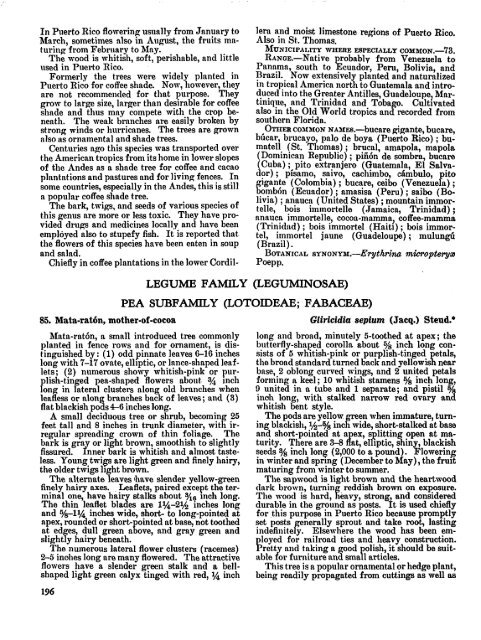Common Trees of Puerto Rico and the Virgin Islands
Common Trees of Puerto Rico and the Virgin Islands
Common Trees of Puerto Rico and the Virgin Islands
You also want an ePaper? Increase the reach of your titles
YUMPU automatically turns print PDFs into web optimized ePapers that Google loves.
In <strong>Puerto</strong> <strong>Rico</strong> flowering usually from January to<br />
March, sometimes also in August, <strong>the</strong> fruits ma-<br />
turing from Febrllary to May.<br />
The wood is whitish, s<strong>of</strong>t, perishable, <strong>and</strong> little<br />
used in <strong>Puerto</strong> <strong>Rico</strong>.<br />
Formerly <strong>the</strong> trees were widely planted in<br />
<strong>Puerto</strong> <strong>Rico</strong> for c<strong>of</strong>fee shade. Now, however, <strong>the</strong>y<br />
are not recommended for that purpose. They<br />
grow- to large size, larger than desirable for c<strong>of</strong>fee<br />
shade <strong>and</strong> thus may compete with <strong>the</strong> crop be-<br />
neath. The \real< branches are easily broken by<br />
strong winds or hurricanes. The trees are grown<br />
also as ornamental <strong>and</strong> shade trees.<br />
Centuries ago this species was transported over<br />
<strong>the</strong> American tropics from its home in lower slopes<br />
<strong>of</strong> <strong>the</strong> Andes as a shade tree for c<strong>of</strong>fee nnd cacao<br />
plantations <strong>and</strong> pastures <strong>and</strong> for living fences. In<br />
some countries, especially in <strong>the</strong> Andes, this is still<br />
a popular c<strong>of</strong>fee shade tree.<br />
The bark, twigs, <strong>and</strong> seeds <strong>of</strong> various species <strong>of</strong><br />
this genus are more or less toxic. They have pro-<br />
vided drugs <strong>and</strong> medicines locally <strong>and</strong> have been<br />
employed also to stupefy fish. It is reported that<br />
<strong>the</strong> flowers <strong>of</strong> this species have been eaten in soup<br />
<strong>and</strong> salad.<br />
Chiefly in c<strong>of</strong>fee plantations in <strong>the</strong> lower Cordil-<br />
LEGUME FAMILY (LEGUMINOSAE)<br />
lera <strong>and</strong> moist limestone regions <strong>of</strong> <strong>Puerto</strong> <strong>Rico</strong>.<br />
Also in St. Thomas.<br />
MU~ICIPA~,ITY TVHERE EBPECWLLY COMMON.-73.<br />
RANGE.-Native robably from Venezuela to<br />
Panama, south to %cuador, Peru, Bolivia, <strong>and</strong><br />
Brazil. Now extensively planted <strong>and</strong> naturalized<br />
in tropical America north to Guatemala <strong>and</strong> introduced<br />
into <strong>the</strong> Greater Antilles, Guadeloupel Martinique,<br />
<strong>and</strong> Trinidad <strong>and</strong> Tobago. Cultivated<br />
also in <strong>the</strong> Old World tropics <strong>and</strong> recorded from<br />
sou<strong>the</strong>rn Florida.<br />
Onm~ co~rafo~ NAXES.-bucare gigante, bucare,<br />
b6car, brucayo, palo de boya (<strong>Puerto</strong> <strong>Rico</strong>) ; bumatell<br />
(St. Thomas) ; brucal, amapola, mapola<br />
(Dominican Republic) ; piii6n de sombra, bucare<br />
(Cuba) ; pito evtranjero (Guatemala, El Salvador)<br />
; pisamo, saivo, cacliimbo, c6mbul0, pito<br />
gigante (Colombia) ; bumre, wibo (Venezuela) ;<br />
bomb6n (Ecuador) ; nmasisa (Peru) ; saibo (Bolivia)<br />
; anauca (United States) ; mountain immortelle,<br />
bois imlnortelle (Jamaica, Trinidad) ;<br />
anauca immortelle, cocoa-mamma? c<strong>of</strong>fee-mamma<br />
(Trinidad) ; bois immortel (Haitl) ; bois immortel,<br />
immortel jaune (Guadeloupe) ; mulungi<br />
(Brazil).<br />
BOTANICAL sr~onnf.-Eqthm'na micropterym<br />
PWPP.<br />
PEA SUBFAMILY (LOTOIDEAE; FABACEAE)<br />
85. Mata-ratbn, mo<strong>the</strong>r-<strong>of</strong>-cocoa Gliricidia sepium (Jacq.) Stead.'<br />
Mata-rathn, a small introduced tree commonly<br />
planted in fence rows <strong>and</strong> for ornament, is distinguished<br />
by : (1) odd pinnate leaves 6-16 inches<br />
long with 7-17 ovate, elliptic, or lance-shaped leaflets;<br />
(2) numerous showy whitish-pink or purplish-tinged<br />
pea-shaped flowers about % inch<br />
long in lateral clusters along old branches when<br />
leafless or alon branches back <strong>of</strong> leaves; <strong>and</strong> (3)<br />
flat blackish po 5 s 4-6 inches long.<br />
A small deciduous tree or shnib, becoming 25<br />
feet tall <strong>and</strong> 8 inches in trunk diameter, with irmgular<br />
spreading crown <strong>of</strong> thin foliage. The<br />
bark is pity or light brown, smoothish to slightly<br />
fissured. Inner bark is whitish <strong>and</strong> almost tasteless.<br />
Young twigs are light green <strong>and</strong> finely hairy,<br />
<strong>the</strong> older twigs light brown.<br />
The alternate leaves have slender yellow-green<br />
finely hairy axes. Leaflets, paired except <strong>the</strong> terminal<br />
one, have hair stalks about s/16 inch long.<br />
The thin leaflet bldes are l'/r-2% inches long<br />
<strong>and</strong> inches wide, short- to long-pointed at<br />
apex, rounded or short- ointed at base, not too<strong>the</strong>d<br />
at ed es, dull green a ove, <strong>and</strong> gray green <strong>and</strong><br />
7<br />
slight y hairy beneath. g<br />
The numerous lateral flower clusters (racemes)<br />
2-6 inoles long are many flowered. The attractive<br />
flowers have a slender green stalk <strong>and</strong> a bell-<br />
shaped light green calyx tinged with red, '/r inch<br />
long <strong>and</strong> broad, minutely 5-too<strong>the</strong>d at apex; <strong>the</strong><br />
butterfly-shaped corolla about s/8 inch long consists<br />
<strong>of</strong> 5 whitish-pink or purplish-tinged etals,<br />
<strong>the</strong> broad st<strong>and</strong>ard turned back <strong>and</strong> yellowis i near<br />
bnse, 2 oblong curved wings, <strong>and</strong> 2 united petals<br />
forming a keel; 10 whitish stamens ."/s inch long,<br />
9 united in a tube <strong>and</strong> 1 separate; <strong>and</strong> pistil 6/<br />
inoh long, with stalked narrow red ovary an61<br />
whitish bent style.<br />
The pods are yellow pen when immature, turning<br />
blackish, s-% inch wide, short-stalked at base<br />
<strong>and</strong> short-pointed at a ex, splitting open at maturity.<br />
There are 3-8 d' at, elliptic, shin , blackish<br />
seeds % inch long (2,000 to a pound). $lowering<br />
in winter <strong>and</strong> sprlng (December to May), <strong>the</strong> fruit<br />
maturing from winter to summer.<br />
The snpwood is light brown <strong>and</strong> <strong>the</strong> heartwood<br />
dark brown, turnin reddish brown on exposure.<br />
The nvood is hard, f ieavy, strong, <strong>and</strong> considered<br />
durable in <strong>the</strong> ground as posts. It is used chiefly<br />
for this purpose in <strong>Puerto</strong> <strong>Rico</strong> because promptly<br />
set posts generally sprout <strong>and</strong> take root, lasting<br />
indefinitely. Elsewhere <strong>the</strong> wood has been emloyed<br />
for railroad ties <strong>and</strong> heavy construction.<br />
bretty <strong>and</strong> taking a ood olish, it should be suitable<br />
for furniture an sma P 1 articles.<br />
This tree is a popular ornamental or hedge plant,<br />
being readily propagated from cuttings as well as

















